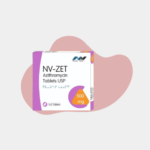Description
NV-ZET 250MG TABLETS
Sure! Let’s dive even deeper into Azithromycin (250 mg), breaking down its mechanisms, therapeutic uses, side effects, and more to give you a clearer understanding.
1. Drug Overview:
Azithromycin is a macrolide antibiotic, belonging to the group of antibiotics that work by inhibiting bacterial protein synthesis. Macrolides, like Azithromycin, target the bacterial ribosome, disrupting the ability of the bacteria to produce proteins, effectively stopping bacterial growth and reproduction. This makes Azithromycin highly effective for a wide range of bacterial infections.
2. Drug Group:
Azithromycin belongs to the macrolide group of antibiotics, which includes drugs like erythromycin, clarithromycin, and others. They share the common feature of being able to bind to the ribosome inside bacterial cells, preventing them from making proteins needed for survival and reproduction.
3. How Azithromycin Works:
Mechanism of Action:
Azithromycin is a bacteriostatic drug, meaning it stops bacteria from multiplying, rather than directly killing them. It does this by binding to the 50S ribosomal subunit in the bacteria. This prevents the bacteria from synthesizing proteins that are essential for their survival. When bacteria can’t make the proteins they need, they can’t grow, replicate, or repair themselves, leading to the cessation of the infection.
Pharmacokinetics:
Pharmacokinetics refers to how the drug is absorbed, distributed, metabolized, and excreted by the body.
Absorption: Azithromycin is well-absorbed in the gastrointestinal tract. After oral administration, it reaches peak concentrations in the bloodstream in about 2-3 hours. It’s absorbed into the bloodstream efficiently, though food can slow its absorption slightly.
Distribution: Azithromycin is known for its excellent tissue penetration. It’s distributed widely throughout the body, including in high concentrations in tissues such as the lungs, tonsils, skin, and middle ear—areas that are common sites of infection.
Metabolism: Azithromycin is only minimally metabolized by the liver. This is significant because it means the drug doesn’t get broken down extensively by the liver, which could otherwise limit its effectiveness.
Excretion: Azithromycin has an exceptionally long half-life of about 68 hours. This is why it is effective for a long time after just a single dose. It is mainly excreted via the bile (a digestive fluid from the liver), with a small amount excreted in urine. This extended half-life allows for shorter treatment courses.
4. Key Uses (What It Treats)
Azithromycin is used to treat a variety of bacterial infections. Its ability to effectively treat a broad range of infections makes it a first-line choice in many cases.
Common Uses:
Respiratory Infections:
Pneumonia: Azithromycin is often used to treat bacterial pneumonia, a lung infection that causes symptoms like cough, fever, and difficulty breathing.
Bronchitis: It’s used to treat acute exacerbations of chronic bronchitis, often in patients who have underlying chronic obstructive pulmonary disease (COPD).
Sinusitis: Azithromycin can help treat bacterial infections in the sinuses, causing facial pain, nasal congestion, and a runny nose.
Ear Infections (Otitis Media):
Azithromycin is commonly prescribed for ear infections, especially in children, where it works well for middle ear infections (otitis media).
Skin and Soft Tissue Infections:
It can treat skin infections like cellulitis, impetigo, and infected wounds.
Sexually Transmitted Infections (STIs):
Azithromycin is used to treat bacterial STIs such as chlamydia and gonorrhea, sometimes in combination with other antibiotics.
Pharyngitis (Sore Throat):
Azithromycin can be used to treat bacterial sore throats, especially those caused by Streptococcus pyogenes (the bacteria responsible for strep throat).
Chronic Conditions:
For people with chronic obstructive pulmonary disease (COPD), Azithromycin can be used to prevent flare-ups caused by bacterial infections.
5. Special Uses
Azithromycin’s long half-life and wide tissue distribution make it ideal for treating respiratory and ear infections. It’s also used in preventing bacterial exacerbations in COPD, a condition where chronic inflammation in the airways leads to periodic worsening of symptoms.
Additionally, its once-daily dosing is extremely convenient, especially for individuals with multiple health issues or those needing long-term treatment. This shortened treatment duration (typically 5 days) makes it easier for patients to adhere to the medication plan compared to antibiotics that require a longer course.
6. Side Effects
Azithromycin is generally well tolerated, but like all medications, it can cause side effects. Here are the common and rare side effects associated with Azithromycin:
Common Side Effects:
Gastrointestinal Issues:
Nausea, diarrhea, vomiting, or abdominal pain are the most frequently reported side effects. These usually resolve after the treatment is finished.
Headache: Some patients may experience mild headaches or dizziness.
Serious Side Effects (less common):
QT Prolongation:
Azithromycin can cause prolongation of the QT interval, which is a change in the heart’s electrical activity. This can lead to irregular heart rhythms (arrhythmias), which can be dangerous, especially in people with pre-existing heart conditions or those taking other drugs that affect the heart.
Liver Problems:
Although rare, liver damage can occur. Symptoms of liver issues include yellowing of the skin and eyes (jaundice), dark urine, and severe abdominal pain.
Severe Allergic Reactions:
Some patients may experience severe allergic reactions such as swelling of the lips, face, or throat, difficulty breathing, or skin rash. If these symptoms occur, it’s essential to seek emergency medical help.
7. Benefits of Azithromycin
Broad-Spectrum Activity: Azithromycin is highly effective against a wide range of bacteria, making it suitable for many different types of infections.
Convenient Dosing: The long half-life allows for once-daily dosing, making it easier for patients to follow the prescribed regimen.
Short Treatment Duration: Azithromycin is often prescribed for just a 5-day course, which improves patient adherence compared to longer antibiotic treatments.
Fewer Side Effects: Azithromycin generally has fewer gastrointestinal and allergic side effects compared to other antibiotics.
8. Pregnancy Safety
FDA Category B: Azithromycin is classified as Category B during pregnancy. This means that studies in animals have not shown any harm to the fetus, and while no human studies exist, it is generally considered safe for use during pregnancy when needed.
Always consult with a healthcare provider before using any medication during pregnancy to ensure it is the best option for both the mother and the baby.
9. Drug Interactions
While Azithromycin is generally well-tolerated, it can interact with other medications:
Antiarrhythmic drugs (used to treat heart problems) and other drugs that prolong the QT interval can increase the risk of serious heart rhythm problems.
Antacids containing aluminum or magnesium may reduce Azithromycin’s absorption, so it’s best to take them 2 hours apart.
—
Conclusion:
Azithromycin (250 mg) is a macrolide antibiotic that is widely used to treat various bacterial infections, particularly those affecting the respiratory tract, ear, and skin. Its once-daily dosing and short treatment course make it a convenient option for patients. While generally safe and well-tolerated, it can cause side effects such as gastrointestinal issues, liver problems, or heart rhythm disturbances in rare cases. It is classified as Category B for pregnancy, meaning it is generally safe for use during pregnancy but should be taken under a healthcare provider’s supervision.








Reviews
There are no reviews yet.